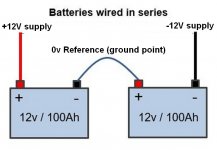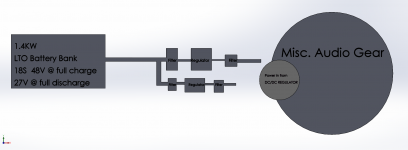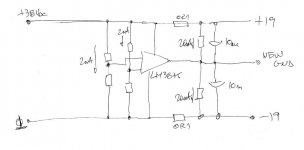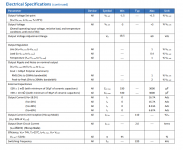-Hello, circuit gurus-
This my first post and I'm hoping to get some insight about the Pass -18V power requirement for the M2x build.
I'm working out plans to build a large battery powered system (sans AC inverter) and my regulated DC range is from 9V-50V @ 40A. The system initially began with a B1 Nutube paired with Icepower. Those plans expanded to a twin B1 four channel and I was hoping to roll one of the Pass amp designs into the second pair of channels. AC200 monos for the low end and the M2x for the mids/highs.
Being a noob to circuitry I'm getting the impression that producing that -18V from a DC source is not a trivial task. The Icepower units need a negative source also, but the current requirements are minimal and I found several out of the box options for that.
Can anyone offer a workable strategy to do this, or is it more practical to work with a different amp?
This my first post and I'm hoping to get some insight about the Pass -18V power requirement for the M2x build.
I'm working out plans to build a large battery powered system (sans AC inverter) and my regulated DC range is from 9V-50V @ 40A. The system initially began with a B1 Nutube paired with Icepower. Those plans expanded to a twin B1 four channel and I was hoping to roll one of the Pass amp designs into the second pair of channels. AC200 monos for the low end and the M2x for the mids/highs.
Being a noob to circuitry I'm getting the impression that producing that -18V from a DC source is not a trivial task. The Icepower units need a negative source also, but the current requirements are minimal and I found several out of the box options for that.
Can anyone offer a workable strategy to do this, or is it more practical to work with a different amp?
Maybe I can tweak my query to be more interesting-
You live in the woods and your only power source is solar.
Your power supply is DC and all of your utilities run DC.
You want to enjoy some Class A goodness in di woods.
What do you do?
Convert to AC using an inverter just to have that negative side for one amp?
I'm hoping there is better way to do this....
You live in the woods and your only power source is solar.
Your power supply is DC and all of your utilities run DC.
You want to enjoy some Class A goodness in di woods.
What do you do?
Convert to AC using an inverter just to have that negative side for one amp?
I'm hoping there is better way to do this....
Seems like you’d need to double your DC input, then utilize some circuitry to split it and establish a new zero volt reference. That’s just a guess, I don’t really have a great answer.
you need artificial GND generator, to get mid point of your 0 to pos.rail
see Quad 606 schematic, just do it with more potent transistors
circuit part - T15,T16
calc colector resistor values for at least .......30mA , tweak base resistors for symmetry
I'm sure there are better solutions , one of them involving LM3875 , but this one is good enough for start
see Quad 606 schematic, just do it with more potent transistors
circuit part - T15,T16
calc colector resistor values for at least .......30mA , tweak base resistors for symmetry
I'm sure there are better solutions , one of them involving LM3875 , but this one is good enough for start
Attachments
Thanks for chiming in, codyt!
Yeah, it seems like a bit of a conundrum from what I have been able to glean from online sources. There are half a dozen ways to do it with things like charge pumps, flyback converters and so on, but they all seem to be very low current solutions. It is not yet clear to me how much current that 18V negative needs to sustain however my sense is that these Pass designs use some comparatively large currents on the negatives.
The AC200 Icepower I'm tinkering with has a -12V side but it's something in the ma range and it was a matter of a ten second search on Digi to find a plug-n-play to handle that.
It would be crazy if I end up having to run an inverter just for that but maybe that is the simplest way to go lol!
Yeah, it seems like a bit of a conundrum from what I have been able to glean from online sources. There are half a dozen ways to do it with things like charge pumps, flyback converters and so on, but they all seem to be very low current solutions. It is not yet clear to me how much current that 18V negative needs to sustain however my sense is that these Pass designs use some comparatively large currents on the negatives.
The AC200 Icepower I'm tinkering with has a -12V side but it's something in the ma range and it was a matter of a ten second search on Digi to find a plug-n-play to handle that.
It would be crazy if I end up having to run an inverter just for that but maybe that is the simplest way to go lol!
Very cool, Zen Mod! This looks like the avenue I needed.
Wrapping my brain around it remains to bee seen, but it's nice to have something to chew on-
Wrapping my brain around it remains to bee seen, but it's nice to have something to chew on-
Pass DIY Addict
Joined 2000
Paid Member
Thanks, Eric!
My general setup is from a battery bank feeding into a 50 amp 9-60V adjustable buck boost regulator. My assumption is that anything going into the M2 will need to be regulated. My battery voltage drop is 48V at full charge to 27V at fully discharged. Are you suggesting there is a way to run the raw batteries to the M2 supply?
Also, your point raises the question-- batteries have that negative side as inherent to how they operate, but a switching regulator will loose that aspect at the output? Hence the need for special circuits to accomplish that polarity swap is how I am interpreting this problem as a level 1 circuit scrub 😀
My general setup is from a battery bank feeding into a 50 amp 9-60V adjustable buck boost regulator. My assumption is that anything going into the M2 will need to be regulated. My battery voltage drop is 48V at full charge to 27V at fully discharged. Are you suggesting there is a way to run the raw batteries to the M2 supply?
Also, your point raises the question-- batteries have that negative side as inherent to how they operate, but a switching regulator will loose that aspect at the output? Hence the need for special circuits to accomplish that polarity swap is how I am interpreting this problem as a level 1 circuit scrub 😀
Pass DIY Addict
Joined 2000
Paid Member
Yep, pictures always help.
Sounds like all you really need is a good voltage regulator between your batteries and the amp circuit. Whatever voltage you have coming out of the batteries need to be regulated down to about +24v and -24v. You have some wiggle room here, +/- 22v is fine as well. You don't want to go feeding that amp +/- 48v, it'll get cooked for sure.
Sounds like all you really need is a good voltage regulator between your batteries and the amp circuit. Whatever voltage you have coming out of the batteries need to be regulated down to about +24v and -24v. You have some wiggle room here, +/- 22v is fine as well. You don't want to go feeding that amp +/- 48v, it'll get cooked for sure.
You also don't want to feed the amp with whatever voltage the batteries happen to be charging / discharging at. A regulator is definitely needed.
Thanks to everyone in the convo-
Attached is a very high level view of the scenario. I think the real point of interest is gonna be at the regulators I'm working with. I have two styles of adjustable high power buck/boost regulators.
The ABB will do 18-80V in and 18-60V out with a 6.7A max.
The Delta is a total beast and will do 9-60V in and 0-60V @ 50A max.
I'm attaching the spec of both regs. as well.
Attached is a very high level view of the scenario. I think the real point of interest is gonna be at the regulators I'm working with. I have two styles of adjustable high power buck/boost regulators.
The ABB will do 18-80V in and 18-60V out with a 6.7A max.
The Delta is a total beast and will do 9-60V in and 0-60V @ 50A max.
I'm attaching the spec of both regs. as well.
Attachments
ok, regs are having settable output voltage
are they dedicated solely for audio gadgets, or you intend to set them to any particular voltage and use for other purposes ?
are they dedicated solely for audio gadgets, or you intend to set them to any particular voltage and use for other purposes ?
@ Zen Mod-
The ideal scenario is to run everything on approx 19V or double that. The rational is because computer monitors, thin-mini-ITX computers, and possibly the B1 Nutube (and of course the M2) can operate in that 19V ballpark.
Having said that, nothing is set in stone and I have no problem running a completely separate/custom solution to the M2. Those regulators are negotiable too. I have just never come across anything more dense in terms of output as well as being somewhat cost effective. The ABB is about 60$ and the Delta goes from 220-300$ With a 50A max rating I can't even find anything to compete with it. EDIT: By separate, I'm referring to any and everything, so long as it's coming from the battery. And hey, since this is audio I'd be more that happy to get into some non switching solutions too. I realize that if a pure sine wave inverter were to feed an transformer there could be serious benefits to doing that--for sound quality, strictly speaking. It still begs the question, what is the best solution, both in terms of sound quality and circuit practicality? It has been my thinking that hey, BATTERY POWER, ASR Emitter! I hear batteries make for some smooth power-
As was mentioned by codyt, there may be a way to double voltage and work from there on the solution. That would also have it's benefits. If the primary voltage source were to be set at say 40V, I could use that to power an Icepower module directly, plus whatever needs to happen downstream to make the Pass style amps happy and create the proper polarities.
The ideal scenario is to run everything on approx 19V or double that. The rational is because computer monitors, thin-mini-ITX computers, and possibly the B1 Nutube (and of course the M2) can operate in that 19V ballpark.
Having said that, nothing is set in stone and I have no problem running a completely separate/custom solution to the M2. Those regulators are negotiable too. I have just never come across anything more dense in terms of output as well as being somewhat cost effective. The ABB is about 60$ and the Delta goes from 220-300$ With a 50A max rating I can't even find anything to compete with it. EDIT: By separate, I'm referring to any and everything, so long as it's coming from the battery. And hey, since this is audio I'd be more that happy to get into some non switching solutions too. I realize that if a pure sine wave inverter were to feed an transformer there could be serious benefits to doing that--for sound quality, strictly speaking. It still begs the question, what is the best solution, both in terms of sound quality and circuit practicality? It has been my thinking that hey, BATTERY POWER, ASR Emitter! I hear batteries make for some smooth power-
As was mentioned by codyt, there may be a way to double voltage and work from there on the solution. That would also have it's benefits. If the primary voltage source were to be set at say 40V, I could use that to power an Icepower module directly, plus whatever needs to happen downstream to make the Pass style amps happy and create the proper polarities.
Last edited:
so, if having dedicated regs, there is no other solution than using arrangement with 38V of reg output, then electronically made (call it artificial) GND, so amp(s) fed from (2x19V)=38V, while small gadgets fed from GND and upper raill , resulting in +19V
I'm sure that I have somewhere schm drawn nicely, got from web, but I can't find it now
so I sketched this, hope bright brains around would catch a mistake, if I made it
edit:
resistors - all 4 left of LM3875 are 10K , each , two resistors right of LM are 1K each
left are regular small MF jobies, while right one - use 1W or 2W ones, MOX or whatever
I'm sure that I have somewhere schm drawn nicely, got from web, but I can't find it now
so I sketched this, hope bright brains around would catch a mistake, if I made it
edit:
resistors - all 4 left of LM3875 are 10K , each , two resistors right of LM are 1K each
left are regular small MF jobies, while right one - use 1W or 2W ones, MOX or whatever
Attachments
Last edited:
That looks like just the thing, Zen Mod 
One catch-- the LM3875T is looking like it's pretty hard to get. I see them on ebay coming out of China and my impression is that is not safe bet.
I did find the LM3886T which is an active part and happens to be of the Overture ilk. It's rated at 68W @ 4R but the spec does say it will do 50W @ 8R if the voltage is cranked up to 35V, so it looks like 38V from the reg. will be perfect. I'll attach the spec sheet, can you verify if the replacement is suitable? If so, it will go on order.
I like this scenario way more than using an inverter ;D

One catch-- the LM3875T is looking like it's pretty hard to get. I see them on ebay coming out of China and my impression is that is not safe bet.
I did find the LM3886T which is an active part and happens to be of the Overture ilk. It's rated at 68W @ 4R but the spec does say it will do 50W @ 8R if the voltage is cranked up to 35V, so it looks like 38V from the reg. will be perfect. I'll attach the spec sheet, can you verify if the replacement is suitable? If so, it will go on order.
I like this scenario way more than using an inverter ;D
Attachments
any proper Power OP will do, for smaller voltages TDA 2002/2003 will do
LM 3875 just popped up from memory
LM 3875 just popped up from memory
Update:
Single channel powered by 39V source at 1.37A. Rails are ~ 19.5V.
B1 Nutube powered from 19.5V rail.
Sounds amazing-- THANK YOU ZEN MOD!!!
Next challenge:
It's currently running from a lab grade bench top power supply. Making the transition to to the battery powered DC/DC regulator is looking
complicated because the 400W ABB regulator mentions a 3000uF max capacitance (due to ringing and several other possible problems).
Given the battery source, will I need the traditional 60,000+uF per channel, or will the batteries act as caps and circumvent the need?
The B1 alone already exceeds that 3000uF in just the basic config😀 The current setup has no supply caps but the Sorensen DCS 40-25
might be cheating compared to the intended power supply config. Attached is the spec. I'm referring to on the regulator-
Single channel powered by 39V source at 1.37A. Rails are ~ 19.5V.
B1 Nutube powered from 19.5V rail.
Sounds amazing-- THANK YOU ZEN MOD!!!
Next challenge:
It's currently running from a lab grade bench top power supply. Making the transition to to the battery powered DC/DC regulator is looking
complicated because the 400W ABB regulator mentions a 3000uF max capacitance (due to ringing and several other possible problems).
Given the battery source, will I need the traditional 60,000+uF per channel, or will the batteries act as caps and circumvent the need?
The B1 alone already exceeds that 3000uF in just the basic config😀 The current setup has no supply caps but the Sorensen DCS 40-25
might be cheating compared to the intended power supply config. Attached is the spec. I'm referring to on the regulator-
Attachments
- Home
- Amplifiers
- Pass Labs
- M2x powered from DC source



